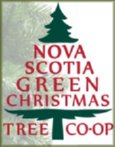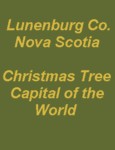Are real Christmas trees environmentally friendly.........You bet, read on.
Let's start at the beginning:
Christmas trees an extremely friendly farm crop, both to our environment and to people and animals. A broad network of roots holds the soil and a continuous ground cover prevents surface erosion by water and wind.
As a long term crop, trees allow a natural buildup of bird and animal populations. Tree farms provide stable refuge and feeding areas for wildlife, often very near large urban centres, at no cost to the taxpayer
Every acre of Christmas trees produces enough oxygen for 18 people.
Christmas tree lots regenerate naturally. They are never clearcut.
Real or artificial? Artifical trees look good for a couple of years but they, like everything else, wear out. They then need to be replaced and the old one goes in the land fill. Artifical trees are generally made of petroleum products (PVC) so when they become part of the land fill, that is how they stay, forever in the land fill. REAL Christmas trees, on the other hand, never just remain as land fill because they are biodegradable or can be recycled.
Recycling Your Christmas Tree - 12 Ideas for the 12 days of Christmas

1. Christmas trees are biodegradable. The branches and needles make excellent mulch for your garden. Many communities collect the trees and put them through shredders and then offer them for sale in the spring for mulch for gardens.
2. When you take your tree out of your house, how about "re-decorating" it in your yard as a bird shelter and feeder. Secure the tree in the ground and hang orange slices will attract birds, as will peanut butter spread on tree seed cones, strung popcorn or hang suet balls stuffed with sunflower seeds. If you set your tree outside for the birds, remember to careully remove all tinsel. Birds will try to eat the shiny stuff and it will make them sick. Eventually (within a year) the branches will become brittle and you can break the tree apart by hand or chip it in a chipper.
3. Fir tree foliage can be stripped from the branches and snipped into small pieces for stuffing into aromatic fir needle pillows for the sofa or bedroom. Some people also use fir foliage in dresser drawers to give clothing and blankets a fragrant aroma.
4. Sunk into fish ponds, Christmas trees make excellent refuge and feeding areas.
5. Woodworking hobbyists can make a multitude of items from the trunk of a used Christmas tree including buttons, Christmas reindeer, birdhouses, coasters, gavels and candleholder.
6. Some counties use the shredded trees as a free, renewable and natural path material that fits both the environment and the needs of hikers!
7. Some communities use Christmas trees to make effective sand and soil erosion barriers, especially for lake and river shoreline stabilization and river delta sedimentation management.
8. Cut off all the branches and use the trunk to edge a garden. The trunk can also be strategically placed in your garden as a resting spot for birds, squirrels and other little critters. Learn more in Extend the Life of Your Christmas Tree.
9. The trunk can be sawed into logs and burned in your fireplace. Note: Don't burn the branches, since they can send off sparks
10. Use the needles to make aromatic potpourris and sachets to enjoy year-round. After removing the decorations, strip branches of their needles, which will retain their pungency indefinitely in brown paper bags.
11. If you still have your Christmas tree out in the yard when warm weather appears, there's still a use for it. If permitted in your community, burn the branches and spread the ashes in your garden. The branches contain valuable nutrients and minerals that can enrich the soil and help yield better flowers and vegetables.
12. Move the tree to a corner of your yard and in the spring set it up in your garden as a trellis for peas or beans.

